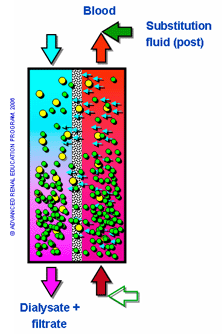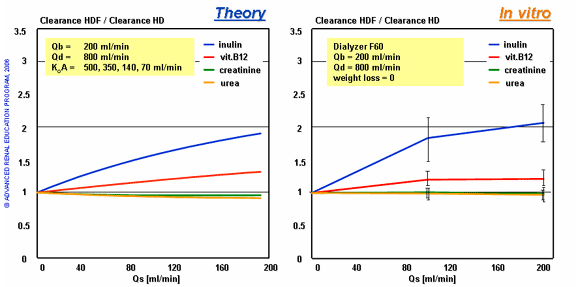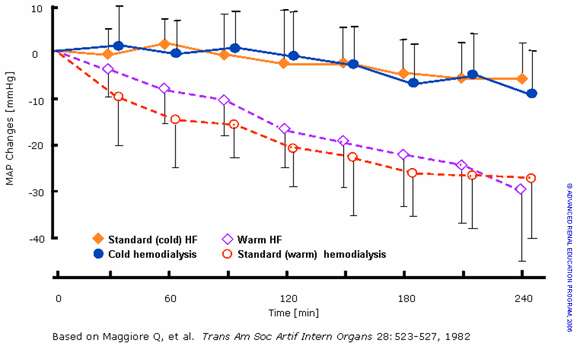Hemodiafiltration
Hemodiafiltration
It is a logical step to combine the respective advantages of both procedures by doing HD and HF in parallel. This procedure is called hemodiafiltration (HDF) and probably originated from work done in the late 70’s by Leber et al. in Giessen, Germany1.
The figure outlines the respective characteristics of this procedure. In terms of solute removal HDF certainly is one of the most efficient ways to treat the blood of uremic patients.
 Principle:
Principle:
– Combination of diffusive and convective solute transport (HD + HF = HDF)
– Volume substitution (pre or post filter) plus dialysate required
Selectivity:
– Low
Efficacy:
– Improved for solutes (small proteins, mediators, etc.)
– High for small molecular weight substances (urea, creatinine, electrolytes, buffer base)
Over the years there have been many publications showing the effect of HDF in comparison to HD and HF, which mainly confirmed what was initially shown2 – HDF really combines the solute removal capabilities of both HD and HF.
Clearance Comparison between HD, HF and HDF
The introduction of HDF brought up the question as to which mode of dilution (pre or post filter) was to be preferred. The problem can be investigated and answered by theoretical considerations and in-vitro experiments as done by Ahrenholz et al.3 While this study specifically refers to online HDF, considerations regarding the efficacy are valid for conventional as well as for online HDF.
As expected, small MW clearances are slightly reduced in pre-dilution mode due to the decreased concentration gradients across the membrane, whereas middle and higher MW clearances increase with increasing filtrate or substitution fluid flow. In the setup described here, inulin clearance can be doubled compared to pure HD. In-vitro experiments nicely follow theory in this case.
HDF efficacy: pre-dilution (based on reference 3):

In the post-dilution mode, small MW efficacy is slightly increased (there is some convective transport for small MW solutes as well) but inulin clearances may reach the three-fold level of HD at the respective filtrate flow level. Taking into consideration that the same range of filtrate flow was used in pre- and in post-dilution modes, one can conclude that post-dilution is the best compromise between solute removal and substitution fluid consumption. Whenever possible, post-dilution should be the modality of choice. As indicated before, matching the small MW performance of post-dilution in a pre-dilution setup is possible but requires larger exchange volumes.
HDF efficacy: post-dilution (based on reference 3):

In making a decision on whether to use pre- or post-dilution modes for HDF, the following should be considered:
-
For blood access flows > 300 ml/min, post-dilution HDF provides the highest clearances at an optimized level of substitution fluid volume
-
For blood flows below 300 ml/min, HF / HDF have to be done in pre-dilution or in mixed dilution mode
-
To achieve small MW clearances comparable to HD in pre-dilution HF, high exchange volumes have to be applied (60 – 90 l per treatment)
-
Depletion effects with high exchange volumes have not been reported but cannot be excluded with the current state of knowledge
Cardiovascular stability and the “Maggiore effect”
The most referred benefit of HF and HDF is the remarkable increase in blood pressure stability. Maggiore et al. in 1982 extended their research on body temperature towards a comparison of HD and HF4. As would be expected from their previous investigations, the respective differences between HD and HF virtually disappeared when both procedures were performed with the same thermal profile. In other words, “cold” hemodialysis is as well tolerated as (standard) hemofiltration and “warm” hemofiltration is as poorly tolerated as (standard) hemodialysis.
It has been well established that procedures such as HF and HDF (mostly for technical reasons) are hypothermic and HD is hyperthermic. Thus, we should consider any study comparing the hemodynamic behavior between HD and HF/HDF to be incomplete if thermal balance is not matched5.
References:
-
Leber HW, Wizemann V, Goubeaud G, Rawer P, Schutterle G. Simultaneous hemofiltration / hemodialysis: an effective alternative to hemofiltration and conventional hemodialysis in the treatment of uremic patients. Clin Nephrol 9:115-121, 1978
-
Wizemann V. Hemodiafiltration–an avenue to shorter dialysis? Contrib Nephrol. 44:49-56,1985
-
Ahrenholz P, Winkler RE, Ramlow W, Tiess M, Mueller W. On-line hemodiafiltration with pre- and postdilution: a comparison of efficacy. Int J Artif Organs 20:81-90, 1997
-
Maggiore Q, Pizzarelli F, Sisca S, Zoccali C, Parlongo S, Nicolo F, Creazzo G. Blood temperature and vascular stability during hemodialysis and hemofiltration. Trans Am Soc Artif Intern Organs 28:523-527, 1982
-
Donauer J, Schweiger C, Rumberger B, Krumme B, Bohler J. Reduction of hypotensive side effects during online-haemodiafiltration and low temperature haemodialysis. Nephrol Dial Transplant 18:1616-22, 2003


